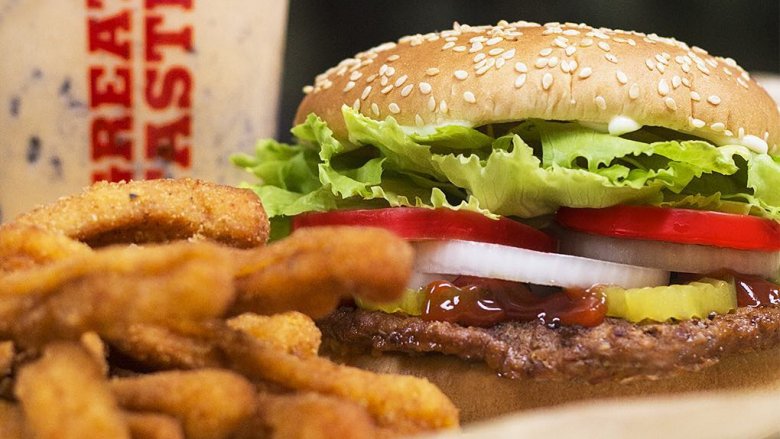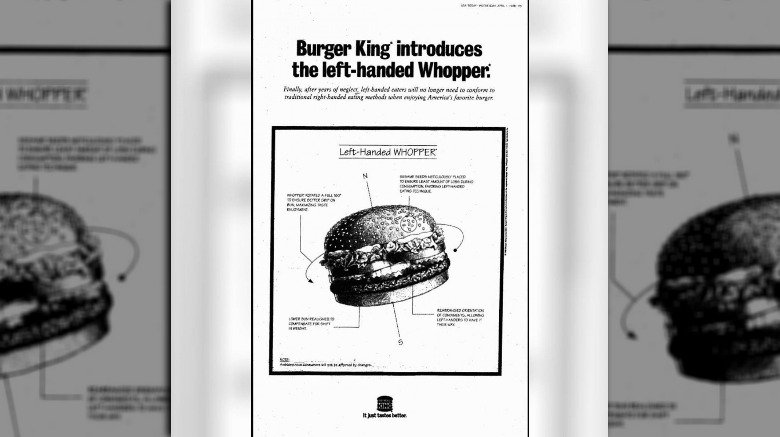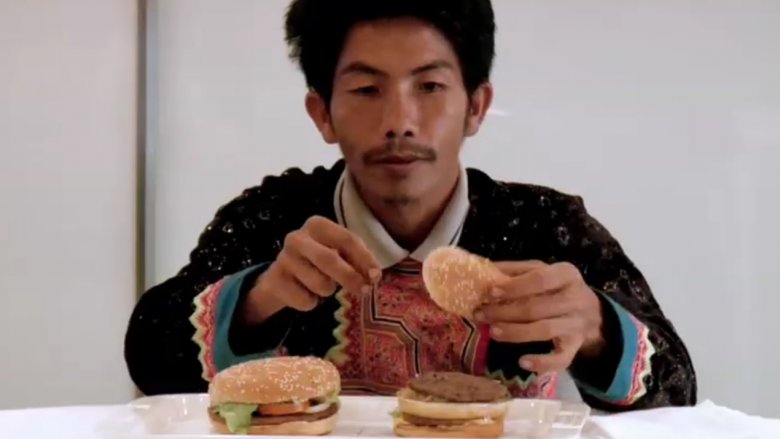What You Don't Know About Burger King's Famous Whopper
Out of all of fast food's most iconic dishes — you know; the bucket of chicken, the BMT, the Frosty, that other famous burger from the Place We Won't Mention Here — the Whopper might just be the original. Introduced over over 60 years ago, this legendary sandwich has become a staple of the burger world and a guaranteed seller for Burger King outlets all over the globe.
But what do you really know about it? Well, it's a hamburger. That bit's easy. More specifically, it's made up of a flame-grilled beef patty, mayo, lettuce, tomato, pickles, ketchup and sliced onion, all contained inside a sesame seed bun. Also, it's pretty huge. It's not exactly the healthiest thing in the world — but that's common knowledge, too. Aside from all that, though, there's a whole history behind the Whopper: a history of accidental creations, geeky slogans, misguided ad campaigns, LGBTQ+ pride, and even horse meat. These are a few things you may not know about Burger King's signature sandwich.
The birth of the Whopper
In the 1950s, co-founder of the restaurant chain Insta Burger King, Jim McLamore, redesigned the company's process for cooking burgers. His method — which utilized a broiler conveyor belt he had patented — led to a better tasting burger, but it was his next creation in 1957 that would make a real splash. He made one of those flame-broiled burgers really big. According to McLamore himself in his autobiography (via The Washington Post), "I suggested that we call our product a Whopper, knowing that this would convey imagery of something big."
The Whopper went unchallenged in the fast food market for years. The Big Mac wouldn't be introduced until 1968, and the real competitor with the Whopper — the Quarter Pounder — didn't appear until 1972. The Whopper spread like wildfire across America, and a legend was born. McLamore went on to serve as president and chairman of Burger King for more than 20 years. He continued as chairman emeritus until he died in 1996.
The (accidental) birth of the Whopper Jr.
The Whopper Jr. is another standard inclusion on any good Burger King menu. It's pretty much exactly what it sounds like: all the same ingredients of an ordinary Whopper, only with a slightly smaller patty and bun. And while it's likely as popular an item as any other at Burger King, it only exists at all because of a lucky mistake.
In 1963, only a few years into the regular Whopper's life, a Burger King employee in Puerto Rico named Luis Arenas Pérez opened up his store for the first time only to find that the molds needed to make the bread for the restaurant's Whoppers hadn't been delivered on time. Instead, Pérez decided to use traditional hamburger buns as a substitute. He gave it the name Whopper Jr. and the restaurant adopted the idea soon after. Pérez was admitted into Burger King's own Hall of Fame for his ingenuity, and went on to become president and CEO of Caribbean Restaurants, the parent company of Burger Kings in Puerto Rico, until his departure in 2006. He died in 2015.
Crunching the numbers
The Whopper has enjoyed a long and varied life in the world of advertising. One of the original slogans ascribed to the sandwich is the claim that "There are 1024 ways to have a Whopper." At first glance, it seems like little more than a boastful non-sequitur, but the truth is that there's a great deal of actual, genuine math behind that assertion.
Think of it like this: each ingredient in the Whopper can be assigned a value of either 0 or 1, based on whether the ingredient is included in your Whopper or not. This is raised to the number of possible ingredients which can be feasibly be included in the Whopper itself. The number they came up with was 1,024. Since there are now many, many more optional ingredients you can include in your Whopper, the number — according to Burger King's ad campaigns — is actually 221,184. Which is a lot of ways to try a burger.
They tried to make it for breakfast
In a move which may or may not have caused nutritionists and health experts around the world to succumb to cardiac episodes, Burger King decided in 2014 to experiment with adding the Whopper to its breakfast menu. Around 5,000 of the chain's restaurants participated in the program, which was dubbed Burgers at Breakfast and also included the addition of Whopper varieties, cheeseburgers, chicken sandwiches and french fries to the pre-noon menu.
Burger King's rival, McDonald's, struck back by introducing an all-day breakfast menu in 2015 — a move which, while it could technically be counted as the exact opposite of what Burger King did, made a whole lot more sense nonetheless. Don't quote us on this, but we'd hazard a guess that giving people muffins for lunch is always going to be a lot more popular than forcing them to eat burgers for breakfast.
What would you give up for a Whopper?
In 2009, Burger King introduced a revolutionary and inflammatory advertising campaign for the Whopper: the Whopper Sacrifice. It came in the form of an app, through which you were able to claim a coupon for a free Whopper on the condition that you un-friended 10 of your friends from Facebook. The app would then send a message to each of the friends you'd deleted, letting them know why they'd just lost a friend — and that your friendship to them was worth only one tenth of the price of a Whopper.
The app — which some might describe as inspired to the point of sheer genius — was met with resistance from Facebook, who requested that Burger King remove the notification message from the app. In response, Burger King terminated the entire campaign. For many, however, it was too late: almost 234,000 people were de-friended in exchange for a Whopper before the app was shut down.
The Whopper invaded Google devices
Not content to let the Whopper Sacrifice be remembered as the burger's sole effort in the world of internet trolling, Burger King went one step further in 2017 with the introduction of their infamous Google ad. The idea, again, was simple yet ingenious: A Burger King employee holds up a Whopper and speaks to the camera: "Okay, Google, what is the Whopper burger?" Any Google Home device which heard the command would then read out a list of the Whopper's ingredients from Wikipedia. It was a nifty little trick which, predictably, angered a lot of people — but got people talking nonetheless. And that's practically striking gold for a marketing campaign.
What Burger King probably didn't see coming was the ingenuity people would use in their attempts to sabotage the campaign. One user edited the Wikipedia article to read: "The Whopper is a burger, consisting of a flame-grilled cow made with 10 percent beef." Another user changed the description to read that the Whopper is the company's worst burger. And another edited the article so that it insisted the Whopper causes cancer.
Things went downhill from there. Before long, Burger King's ad campaign was causing devices across the world to read out that the Whopper contained 100 percent rat, included cyanide, was made from children, and was vastly inferior to the Big Mac. Only three hours after the campaign began, Google pulled the Whopper voice command from its devices.
It helped Ellen get her start
The Whopper's impact on humanity is significant enough as it is when you factor in such things as all those friends lost to that app and the inevitable rising of cholesterol levels all over the planet, but who'd have thought it'd have kick-started the career of Ellen DeGeneres, too?
According to Ellen herself (via HuffPost), she showed up to a fundraiser armed only with a Whopper, fries and a shake. She said, "I went on stage, and I said, 'This is my first time being on stage and I have to admit, I'm a little nervous. I didn't know what I was going to say, and I realized I hadn't eaten all day, so I hope you don't mind — I stopped and grabbed something to eat on the way.' Then I would say, 'But what I wanted to talk about was...' and then I would take a bite. While I was chewing, I'd put a finger up and then just go, 'Oh, that is good. That's better.' And then I would start the sentence again. I ate the entire meal and didn't finish the sentence."
After that bit, her gigs started to pick up, and soon she became the Ellen we know and love today.
They've been made with horsemeat
Beneath the Whopper's folksy origins, witty ad campaigns and intelligent slogans, however, lies a dark and troubling secret. Kind of, at least.
In 2013, Burger King was forced to reveal that some of its burgers — including those used in the Whopper — had been contaminated during the horsemeat scare which gripped the UK at the beginning of that year. A supplier in Ireland was blamed for the contamination (which had lasting effects across the British food industry) and Burger King moved production to Germany and Italy as a precaution. Independent DNA results taken by Burger King on their meat at its source in Ireland revealed the presence of trace levels of equine DNA. Silvercrest, the burger plant at the source of the contamination, was shut for deep cleaning and underwent a change of management as a result of the scandal. Just something to keep in mind next time a fast food chain tells you their burgers are made from 100 percent beef, right?
The Whopper family
Anything that's lasted over 60 years is bound to have been shaken up every now and again, and it's no different for the Whopper. Over the course of the burger's life, the chain has introduced a number of different variants on the Whopper recipe. The standard issue alternatives include the Double and Triple Whoppers, as well as the Bacon and Cheese Whopper, the Veggie Whopper and the pretty much redundant Double Whopper Junior.
But that's not all. Past variants include the Angry Whopper (with pepper jack cheese, jalapenos and "Angry Sauce"), the California Fresh Whopper (with sour cream-onion dressing and cucumbers), the Pinata Whopper (with jalapenos, tortilla chips and hot sauce), the Windows 7 Whopper (which uses seven quarter-pound patties) and even the Whopper with egg. And the list goes on. Most were available only for a short time and in certain countries, sadly, so don't expect to be chowing down on a seven-patty Whopper with egg, cucumber and Angry Sauce anytime soon.
The lefties got some Whopper love
Ever ordered a Whopper at Burger King, sat down to eat it and found that you're just incapable of getting it into your mouth? If so, you might be left-handed. It's a little-known fact that southpaws are, thanks to the burger's unique and complex design, pretty much unable to properly eat a whole Whopper. Luckily, Burger King introduced a Left-Handed Whopper for the very first time in 1998, specifically designed to be eaten by those of us who prefer to live using our left hands. The chain took out an ad in USA Today announcing their new menu item, explaining that every condiment would be rotated 180 degrees to better suit their 1.4 million left-handed customers. Of course, lefties across America rejoiced — at last, somebody had answered their prayers.
Of course, the whole thing was actually just an April Fool's prank. But you've figured that out by now, right?
They're loud and proud
In 2014, Burger King — depending on who you ask — either displayed their support for the LGBTQ+ community or hopped on a corporate bandwagon, by debuting their Proud Whopper. At a branch in San Francisco during the city's pride celebrations, the menu was turned rainbow-colored while visitors who asked for a Proud Whopper were given their burgers wrapped inside a rainbow wrapper, with the words "We Are All the Same Inside" written on the interior. When cashiers were asked what exactly about the Proud Whopper was different to the normal version, they replied, "I don't know."
Otherwise, the public response to the Proud Whopper was predictable — in some instances, grimly so. A few bystanders smiled, some cried with joy or otherwise expressed their solidarity, while others grew angry or announced their intention to never eat at Burger King again. One passerby asked whether gay people even eat fast food.
"We really want to be more than burgers, fries and shakes, and occupy a space that's more meaningful to people," Fernando Machado, a senior vice president of global branding for BK, told TIME.
The Whopper's questionable taste test
Considering just how iconic the Whopper has become since its release over half a century ago, it's hard to imagine the idea that someone could exist out there who doesn't know what one is — let alone someone who doesn't know what a hamburger is. But these people were the focus of a controversial ad campaign back in 2008. The Whopper Virgin Challenge consisted of BK film crews travelling to remote areas of the world to find people (such as Thai villagers, Inuits in Greenland, and farmers in Transylvania) who'd never in their lives eaten a burger — and then offering them a taste test between a Big Mac and a Whopper.
The campaign attracted criticism, however, with commentators and activists lambasting Burger King for its insensitivity to world hunger and the ignorant, colonialist nature of the campaign. A blog post for The Inquisitor said that "It's hard to place exactly where this begins on the level of wrongness."












